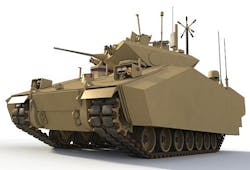Army asks BAE Systems and General Dynamics to recycle GCV vetronics for Future Fighting Vehicle
Officials of the Army Contracting Command in Warren, Mich., awarded $7.9 million study contracts last week to GCV contractors BAE Systems Land & Armaments LP in Sterling Heights, Mich., and to General Dynamics Land Systems (GDLS) in Sterling Heights, Mich., to capitalize on GCV-developed vetronics and similar technologies for a possible Future Fighting Vehicle (FFV).
The Army is asking BAE Systems and GDLS for technical, cost, and risk assessments for technology that leverage GCV technology development for potential use in an FFV. Some big Pentagon programs never die; they simply spin off new programs.
The Ground Combat Vehicle program, cancelled in February due to budget constraints, had been intended to develop a modern armed and armored personnel carrier to replace the Army's Bradley Fighting Vehicle. The GCV had emerged from the ashes of the Army's Future Combat Systems (FCS) program to develop networked manned and unmanned combat vehicles, which was cancelled in 2009 because it was determined to be too expensive.
Related: Army extends Ground Combat Vehicle (GCV) technology development phase by six months
The GCV program, much less ambitious as the FCS program, had been expected before its cancellation to build a protype armored personnel carrier as early as next year, with fielding expected by 2017. Developing the GCV were teams led by BAE Systems and GDLS.
The Bradley, which GCV was to replace, has been in service since 1981, and is expected to remain in the Army inventory perhaps for decades in the future.
The Future Fighting Vehicle has not been clearly defined, and is not yet a program of record. The FFV may represent the Army's latest attempt to build a modern replacement for 33-year-old Bradleys, which have taken a pounding in land wars in Southwest Asia since the 1990s.
Related: These are tough times for the combat vehicle and vetronics industries
In the contract awarded this week, the Army is asking BAE Systems and GDLS to study technologies, costs, and risks against future infantry fighting vehicle requirements for a Future Fighting Vehicle (FFV) system.
From their GCV work, BAE Systems engineers will try to recycle integrated hybrid-electric propulsion and mobility subsystems, automotive test rigs, and hybrid-electric integrated propulsion subsystems.
Due to the use of a hybrid-electric propulsion, the company will design and implement calibration maps for all components within their hybrid systems to test component efficiencies within integrated propulsion systems.
Related: Curtiss-Wright to supply vetronics computers and network switches in GCV competition
On these contracts, BAE Systems and GDLS will do the work in Sterling Heights, Mich., and should be finished next February. For more information contact BAE Systems Land & Armaments online at www.baesystems.com, General Dynamics Land Systems at www.gdls.com, or the Army Contracting Command-Warren at www.tacom.army.mil.
